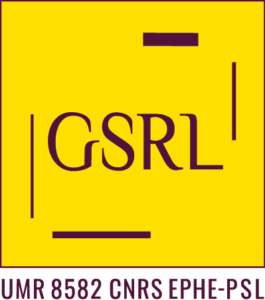Mardi 10 mars 2020 – Séminaire de l’axe « Interactions et créativités religieuses : perspectives anthropologiques »

Séminaire de l’axe
« Interactions et créativités religieuses : perspectives anthropologiques »
2019-2020
Organisé par Detelina Tocheva et Virginie Vaté
Groupe Sociétés, Religions, Laïcités
(GSRL UMR 8582 EPHE–CNRS–PSL)
Campus Condorcet
Bâtiment de Recherche Nord 14, Cours des Humanités 93 322 Aubervilliers
Métro : Ligne 12 – Front Populaire
Après une interruption de plusieurs mois suite au déménagement de notre laboratoire et au mouvement de grève, la première séance de notre séminaire de cette année aura lieule 10 mars 2020 en salle 5.067, 5ème étage, Bâtiment de Recherche Nord
Campus Condorcet, 14 h - 17 h.
Nous aurons la joie d’accueillir Valeria Gazizova (MIASU, Université de Cambridge) autour de son projet de recherche postdoctoral sur
‘Secret Buddhism’ of the Soviet era and its representations
in Kalmyk popular hagiography and visual art
AbstractThrough the lens of oral histories and visual art, the talk explores the construction of public memories and proliferating deification of dissident Buddhist monastics who secretly conducted rituals, gave initiations into Tantric practices and healed by means of Tibetan Buddhist medicine during the Soviet period in Kalmykia. Situated to the northwest of the Caspian Sea, Kalmykia is one of the three ‘autonomous republics’ of Russia where Buddhism is historically practised by its titular population, the westernmost branch of Mongolian peoples. The Stalinist purges of the 1930s erased the Kalmyk Buddhist establishment from the public scene, and until the late 1980s, Buddhism and indigenous forms of popular worship and folk healing remained illegal in Kalmykia. Despite the state persecution, unofficial underground religious centres – if not movements – were functioning around Kalmyk returnee monastics, who had received a Buddhist education (in Russia or abroad) before the Soviet anti-religious campaigns and survived years in Gulag prison-camps. Focusing on the decades of late socialism (1960s – 1980s), commonly known in Kalmykia as the time of ‘secret Buddhism’, I discuss forms of secrecy that were at play in relation to Kalmyk underground Buddhist agents in the situation of a coexistence of politically and culturally antagonistic planes – the plane of communist and that of Buddhist.
Paradoxically or not, these ‘secret lamas’ of the Soviet era have become the focus of contemporary public worship, with new icons (Tib. thang ka) and temples (Kalm. khurul) devoted to them and stories about their magic abilities abounding. Their former places of residence have become pilgrimage sites, associated with miraculous recoveries. The Soviet era, with its political repressions and anti-Buddhist policy, appears essential in this developing hagiography. The talk addresses the incorporation of the ‘Soviet’ into Kalmyk Buddhist cosmology drawing on representations of this process foremost in visual art. Exploring the relationship between memory, history and identity formation, I shall feature contemporary Kalmyk representations of both the ‘Soviet’ and ‘Tibet’ as ‘elsewhere spaces’ which have become instrumental in constructing what is now often defined as the ‘authentic Kalmyk religion’.